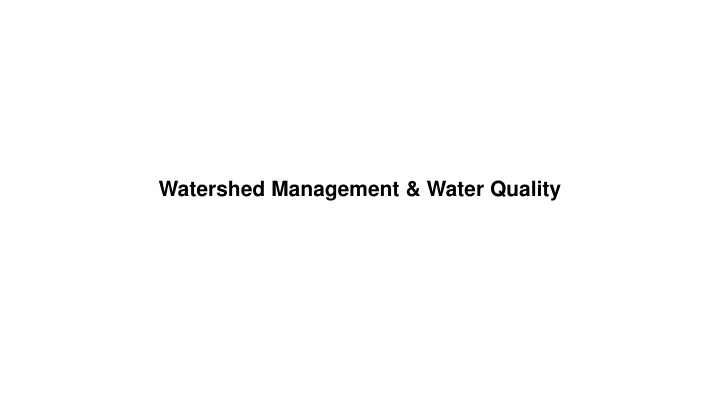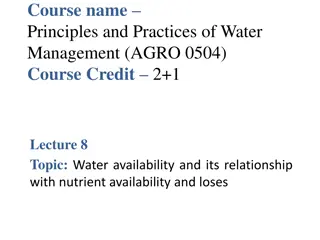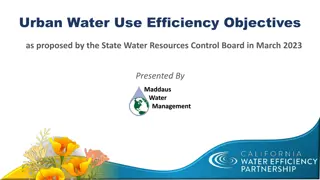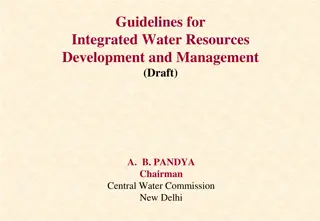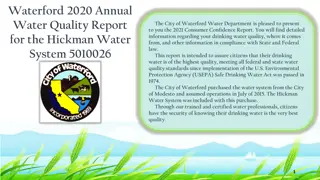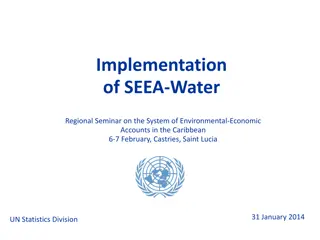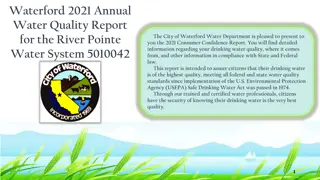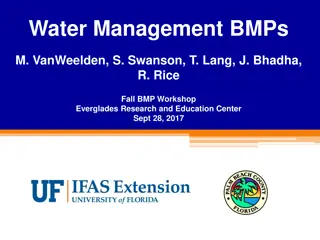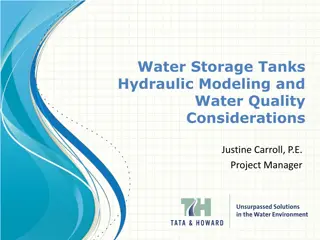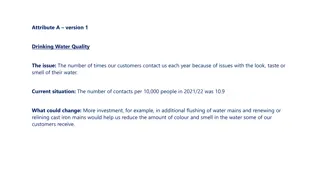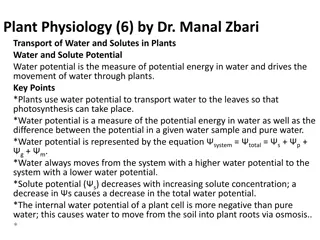Challenges in Water Quality Management
Water quality degradation poses significant challenges in the 21st century, impacting human health, food production, ecosystems, and economic growth. The pollution of freshwater resources by untreated wastewater and emerging pollutants threatens environmental sustainability. Acidification and eutrophication further complicate water quality issues, affecting biodiversity and ecosystem functioning. Effective watershed management is vital for evaluating water quantity, monitoring water quality, and supporting the livelihoods of watershed communities.
Download Presentation

Please find below an Image/Link to download the presentation.
The content on the website is provided AS IS for your information and personal use only. It may not be sold, licensed, or shared on other websites without obtaining consent from the author.If you encounter any issues during the download, it is possible that the publisher has removed the file from their server.
You are allowed to download the files provided on this website for personal or commercial use, subject to the condition that they are used lawfully. All files are the property of their respective owners.
The content on the website is provided AS IS for your information and personal use only. It may not be sold, licensed, or shared on other websites without obtaining consent from the author.
E N D
Presentation Transcript
Water quality is one of the main challenges that societies will face during the 21st century, threatening human health, limiting food production, reducing ecosystem functions and hindering economic growth. Water quality degradation translates directly into environmental, social and economic problems. The availability of the world s scarce water resources is increasingly limited due to the worsening pollution of freshwater resources caused by the disposal of large quantities of insufficiently treated, or untreated, wastewater into rivers, lakes, aquifers and coastal waters.
Furthermore, newly emerging pollutants like personal care products and pharmaceuticals, pesticides, industrial and household chemicals, and changing climate patterns represent a new water quality challenge, with still unknown long-term impacts on human health and ecosystems. Water pollution, resulting from human activities, disturbs aquatic ecosystems not only in structure but also in function, affecting and modifying the integrity of these systems. Clear evidence is eutrophication, which results from high loads of nutrients (phosphorus and nitrogen) primarily from agricultural runoffs, domestic and industrial wastewater and atmospheric inputs from fossil fuel burning.
Acidification is another concerning threat putting more pressure on the complex dynamics of lakes, wetlands and reservoirs. In addition to its health and socio-economic impact, water quality degradation relates directly to biodiversity loss, reduced ecosystem functioning and the unsuitability of water for various uses due to pollution of water resources. Water pollution thus constitutes a serious threat not only to securing enough water of good quality for human needs, but also to meeting the ecosystem needs and maintaining environmental flows.
Water quality involves a long list of individual components and physical, chemical, and biological constituents. A water-quality standard refers to the physical, chemical, or biological characteristics of water in relation to a specified use For example, water-quality standards for irrigation are not necessarily acceptable for drinking water. Changes in water quality resulting from land-use activities on a watershed can make water unusable for drinking but it can still be acceptable for irrigation or other uses.
Hence, Watershed management is Important for: Assessment of water quantity Assessment & monitoring of water quality livelihoods of watershed dwellers Water Quality examination to determine organisms, minerals & organic compounds in water Depending on use of water Physico-chemical, chemical & microbiological analyses of water Common issues of Surface and Groundwater quality are: Pathogenic (Bacteriological) Pollution; Salinity Toxicity (micro-pollutants and other industrial pollutants)
Water Quality Standards It is a measure of the condition of water relative to the requirements of one or more biotic species and/or to any human need or purpose. It is most frequently used by reference to a set of standards against which compliance can be assessed. The most common standards used to assess water quality relate to health of ecosystems, safety of human contact and drinking water.
Water Quality Categories Human consumption Drinking water, including bottled water, may reasonably be expected to contain at least small amounts of some contaminants. Presence of these contaminants does not necessarily indicate that water poses a health risk. Industrial use Dissolved minerals may affect suitability of water for a range of industrial purposes. presence of ions of Ca and Mg which interfere with the cleaning action of soap, & can form hard sulfate and soft carbonate deposits in water heaters/boilers. Hence hard water may be softened to remove these ions. Softening may sacrifice nutrition for cleaning effectiveness.
In the environment. Toxic substances and high populations of certain microorganisms can present a health hazard for non-drinking purposes such as irrigation, swimming, fishing, boating, and industrial uses. These conditions may also affect wildlife, which use the water for drinking or as a habitat. Irrigation purpose, Crop production irrigation water quality requirements Agriculture- single largest user of freshwater - a major cause of degradation of surface and groundwater resources through erosion and chemical runoff
Water Pollution Sources Water pollution is the contamination of water bodies e.g. lakes, rivers, oceans and groundwater. Water pollution occurs when pollutants are discharged directly or indirectly into water bodies without adequate treatment to remove harmful compounds. Water pollution affects plants and organisms living in these bodies of water. The effect is damaging to individual species and populations and natural biological communities.
Water Pollution Source Types 1. Point sources or 2. Non-point sources 1. Point sources: Contaminants that enter a waterway from a single, identifiable source, such as a pipe or ditch. Traced to a specific source Leaking effluents coming from a waste treatment or industrial plant Examples Discharges from a sewage treatment plant; A factory; A city storm drain; Municipal storm sewer systems; Industrial storm water, such as from construction sites
2. Nonpoint source pollution (NPS): Contamination that does not originate from a single discrete source. NPS pollution is the cumulative effect of small amounts of contaminants gathered from a large area. Pollutants will come from wide spread area They can t be traced to a single point or source Examples: Soil erosion, chemical runoff, animal waste pollution leaching out of fertilizers/nutrients from agricultural lands. Nutrient runoff in storm water- agricultural field/forest. Contaminated storm water washed off of parking lots, roads and highways called urban runoff highways, runoff,
Specific Sources Septic systems: Use a large tank buried in the ground to contain and break down household sewage; Fats, oils, and grease as well as large waste particles, are stored and later pumped out of the holding tank; source of concern for groundwater pollution & surface water pollution Waste Disposal: Underground or above ground disposal practices of domestic, municipal, or industrial liquid waste Industrial liquid waste: treated/ untreated Solid waste: Land disposal of municipal and industrial solid waste leaching Mining operations: Mines, Oil & gas- Acid mine drainage, Leaching of toxic metals, Wastewater generated
Causes of Water Pollution Wide spectrum of chemicals, pathogens, and physical or sensory changes such as elevated temperature and discoloration. Natural occurring eg. Salts, fluoride, arsenic, Ca, Mg, Na etc. Artificial disposed by humans from various sources Water's physical chemistry includes acidity (change in pH), electrical conductivity, temperature, and eutrophication
Water Pollution Types 1. Organic pollutants Detergents; Disinfection by-products Food processing waste, fats and grease Insecticides & herbicides, and other chemical compounds Petroleum hydrocarbons, including fuels (gasoline, diesel fuel, jet fuels, and fuel oil) & lubricants (motor oil), & fuel combustion byproducts Tree and bush debris from logging operations Volatile organic compounds (VOCs), such as industrial solvents. Chlorinated solvents, dense non-aqueous phase liquids (DNAPLs), Various chemical compounds found in personal hygiene & cosmetic products
2. Inorganic pollutants Acidity caused by industrial discharges (sulfur dioxide from power plants) Ammonia from food processing waste Chemical waste as industrial by-products Fertilizers containing nutrients- nitrates and phosphates- which are found in storm water runoff from agriculture, as well as commercial and residential use Heavy metals from motor vehicles (via urban storm water runoff) and acid mine drainage Silt (sediment) in runoff from construction sites, logging, slash and burn practices or land clearing sites
Macroscopic - Large visible items polluting the water may be termed "floatables" in an urban storm water context, or marine debris when found on the open water Trash or garbage (e.g. paper, plastic) discarded by people on the ground Dumping of rubbish, that eventually discharged into surface waters Microscopic pollutants micro organisms, dissolved/ dispersed pollutants Thermal pollution: The rise or fall in the temperature of a natural body of water caused by human influence. It results in a change in the physical properties of water. A common cause of thermal pollution is the use of water as a coolant by power plants and industrial manufacturers.
Elevated water temperatures decreases oxygen levels (which can kill fish) and affects ecosystem Urban runoff may elevate temperature in surface waters. Thermal pollution can also be caused by the release of very cold water from the base of reservoirs into warmer rivers.
Important Water Quality Parameters Important physicochemical parameters to be tested for ascertaining water quality are: pH; Color, Taste and Odour, Turbidity, TDS, total hardness, chlorides, sulphates, fluorides, nitrates, calcium, heavy metals, dissolved oxygen, pesticides, detergents & radio-nuclides pH neutral (Ph = 7); acidic (pH<7); basic (pH>7); drinking water (6.5-8) Electrical conductivity water ability to conduct electrical current depends on concentration of dissolved, associated substances
Odour, Colour & Taste: Odour classified as: very weak, weak, clear, strong or very strong Colour tested using colorimter tubes expressed in Hazen standard unit Taste purest form tasteless Turbidity caused by presence of suspended matter ranges in size from colloidal to coarse dispersions measured by Nephelo/turbidity meter & expressed in NTU (Nephelometric turbidity unit) indicator necessity of treatment
Dissolved oxygen indicates amount of oxygen gas dissolved in water solubility of atmospheric oxygen in fresh water ranges from 14.6 mg/l at 0oC to about 7 mg/l at 35oC under 1 atmospheric pressure measured using DO meter. The Biochemical Oxygen Demand (BOD) is an index of the oxygen-demanding properties of biodegradable material in water. BOD amount of dissolved O2demanded by bacteria during stabilization of the decomposable organic matter under aerobic conditions
Nitrate- water soluble molecule made up of nitrogen & oxygen natural constituent of plants In natural form water contains less than 1mg/liter of nitrate nitrogen but higher levels can cause contamination common sources: fertilizers, animal wastes etc. max. permissible 10ppm
Chlorides from dissolved salt deposits, discharge of effluents etc maximum limite: 250 ppm Fluorides - fluorine containing compounds - fluorides - found naturally in low concentration in drinking water and foods Fresh water between 0.01 0.3 ppm, ocean contains between 1.2-1.5 ppm; Maximum permissible 1ppm. = more fluorine diseases like skeletal fluorosis
Hardness represents total concentration of Ca & Mg ions ppm (weight/ volume) Hard water is generally not harmful to one's health, but can pose serious problems in industrial settings. Iron - naturally occurring and not hazardous recommended limit 0.3mg/liter. Heavy Metals: Arsenic, Cadmium, Chromium, Copper, Iron, Manganese, Mercury, Nickel, Silver, Zinc etc. are present in as minerals in soils; also artificially from man made things some of these major contaminations determined by AAS (atomic absorption sepctro-photometer), polarography or colorimetry. Arsenic WHO guideline < 0.05 mg/l
Pesticides: - harmful health effects such as cancer; eg. DDT, Detergents, phenol, radio-nuclides etc. - WHO guideline <0.5 mg/l Microbes indicator potential water borne diseases bacteria viruses & pathogenic protozoa; eg. Coliform bacteria.
Observed Problems Water turns black, smell Acidic taste Alkaline taste Boiled Rice hard and yellow White deposits on boiling Iron taste, change in color after exposure to atmosphere, change in Presence of color of cloths, utensils Oily appearance on top of water body Soap not lathering Brownish black streaks on teeth Growth of Algae Fish kills Salty taste Causes Waste water Low pH High pH High Alkalinity Hardness Presence of Iron compounds hardness Fluoride Nitrate, phosphate Low pH, less DO chloride
Water quality for environmental indicators in relation to watersheds 1. Physical assessment: Total suspended solids (TSS); Temperature; Turbidity; Total dissolved solids (TDS) 2. Chemical assessment: PH; Dissolved oxygen (DO); Biochemical oxygen demand (BOD); Total dissolved solids (TDS); Nutrient concentration/toxins; 3. Biological assessment: pathogens; Exotic species
1. Physical components a. Total suspended solids (TSS) = a measure of the concentration of suspended sediments in water. It indicates the degree of erosion that is taking place or has taken place in the watershed. Measured through water sampling and filtration technique. b. Temperature = the hotness or coldness of water in the stream. It can affect biological organisms directly and indirectly. Temperature affects the amount of dissolved oxygen in water. Measured using portable multi-parameter instruments.
c. Turbidity refers to the clarity of water. It impacts the amount of sunlight a stream receives. Similarly, it determines the depth the sunlight reaches. Turbidity is measured using a Secchi disk or a turbidity meter. 2. Chemical components a. pH A measure of the alkalinity or acidity of water. Highly impacts aquatic organisms and solubility of nutrients in water. Measured using a pH meter.
b. Dissolved oxygen (DO) amount of oxygen present in water. It affects aquatic organisms from micro to macro level. Measured using a DO meter. c. Biological oxygen demand (BOD) a measure of the amount of oxygen bacteria will consume while decomposing organic matter under aerobic conditions. It affects the amount of DO in water. Measured by taking samples in the field and analyzed in the laboratory.
d. Dissolved solids refers to the amount of dissolved nutrients in water, as total dissolved solids (TDS). Measured using a conductivity meter. e. Nutrient concentration/toxins refers to the presence or absence of a chemical contaminant, one that exceeds the safe level. It is of great significance in determining the usefulness of water and the health of the aquatic ecosystem. Measured by taking samples in the field and analyzed in the laboratory.
3. Biological components a. Pathogens refers to the biological contaminant that poses serious health concern. Measured by analyzing fecal coliform count, specifically Escherichia coli species, from the water sample. b. Exotic species refers to non-native aquatic organisms that were introduced in the river/lake system. Normally of concern since it creates havoc to the overall health of the aquatic ecosystem.
READING ASSIGNMENT Read, understand and take important notes on water quality characteristics in relation to watershed management from: CHAPTER -11 of Brooks N.K. et al, 2013, HYDROLOGY AND THE MANAGEMENT OF WATERSHED
Nonpoint source pollution and water-quality characteristics in a watershed Nonpoint-source pollution (NPS) refers to pollution that is associated with land- use activities such as agricultural cultivation, grazing of livestock, and forest management practices which can occur in an unnoticeable manner over wide areas Chemistry of precipitation Air pollution and its influence on precipitation chemistry and dry-deposition additions to terrestrial and aquatic systems are of interest to watershed managers, farmers, and society as a whole.
Acid Precipitation and Atmospheric Chemical Constituents Acid refers to pH values less than 7 in water where pH is defined as the negative log (base 10) of the hydrogen (H+ )-ion activity in moles per liter Acid precipitation became a major environmental issue in the late 1970s and early 1980s in the industrial countries of the northern hemisphere. Naturally occurring precipitation is slightly acidic (pH of 5.6 5.7) because of the reaction of water with normal levels of atmospheric carbon dioxide (CO2) In the late 1970s and early 1980s the industrial countries of northeastern US and northern Europe experienced increasing acid rainfall pH values of 4.5 and 2.4 respectively, were reported.
The increasing acidity of precipitation was caused by the atmospheric inputs of sulfur (S ) and nitrogen (N) oxides from the burning of fossil fuels such as coal and oil. Of major concern are the impacts of acid deposition including both liquid and solid atmospheric particulates on aquatic and terrestrial ecosystems. The effects of acid deposition are a global concern because of the long-range transport of acid by the atmosphere. The impacts of acid deposition on streams and lakes are largely a function of the buffering capacity of soil surrounding them and the size of the watershed
Acids become neutralized and waters may not become acidified if soils are alkaline or contain sufficient calcium (Ca). However, lakes and streams that occur on infertile and shallow soils on top of acidic bedrock and have a low ratio of watershed area to water surface area are susceptible to acidification. Fish and organisms providing their food are generally affected once the pH of streams and lakes drops below 6.0. Acid deposition can inhibit bacterial decomposition and N fixation in the soil and can cause Ca, magnesium (Mg), and potassium (K) to be leached from the soil. Controlling emissions such as sulfate (SO2) and nitrate (NOx) is the key to reducing acid precipitation.
Atmospheric Deposition of Mercury One of the main sources of Hg to watersheds, streams, and lakes is by atmospheric deposition As a trace element in geologic formations, Hg is naturally released by the slow process of weathering though this process does not yield high concentrations to terrestrial and aquatic systems. However, there are several sources of Hg resulting from natural events and people s activities in which Hg becomes volatile. Forest fires and volcanic eruptions expel Hg to the atmosphere. People s activities including metal production, waste handling and treatment, and burning of fossil fuels, wood, and peat contribute to atmospheric Hg.
Once in the atmosphere, Hg becomes widespread and has been found in remote wilderness areas. Hg has a strong affinity for organic matter in soils and surface water. As a result, Hg transport and cycling in a watershed is closely tied to the processes and movement of organic carbon. Atmospheric Hg apparently accumulates on the forest canopy and reaches the soil which acts as a sink.
PHYSICAL CHARACTERISTICS OF SURFACE WATER Among the more important physical characteristics of surface water that related to water quality are: suspended-sediment concentrations, bed-particle size, water temperature, and the level of dissolved oxygen (DO).
Suspended Sediment The physical quality of naturally occurring surface water is determined largely by the amount of sediment that it carries. Of the two components (suspended and bedload), suspended sediment has a greater effect on water-quality because it restricts sunlight from reaching photosynthetic plants measured as turbidity sediment can carry undesirable concentrations of nutrients and heavy metals that affect water quality
Sources of sediment An increase in the sediment load of streams is one of the most widespread causes of degradation in the quality of water from forest, woodland, rangeland, urban, and agricultural watersheds. Surface water from undisturbed forest watersheds has relatively low suspended sediment concentrations (generally < 20 ppm). While much of this sediment originates in the stream channel itself, sediment and/or from surface runoff during large storm events. Where organic soils are prevalent, much of the suspended material in streams is organic particles rather than mineral particles
Higher concentrations of suspended sediment are often the result of accelerated erosion caused by disturbances in drainage areas such as timber-harvesting operations, overgrazing by livestock, road construction, agricultural cultivation, urban expansion, OR natural catastrophes including wildfires, large floods, and landslides.
Nutrient and Heavy-Metal Transport Capacities of Sediment Nutrient and heavy-metal losses from upland watersheds are usually measured by dissolved ion concentrations. However, a potentially important source of nutrient and heavy-metal loss is through its transportation by sediment. Transported sediment from watersheds composed of different bedrock and vegetation combinations can carry high levels of nutrients and heavy metals.
For example, a study of sediment from upland watersheds with limestone, granite, basalt, and sandstone geologies in the southwestern US shows that, limestone is high in Ca and K, basalt is high in sodium (Na). Mg is highest in the sand fraction of basalt and the clay-silt fraction of limestone While sandstone has the lowest concentration of these elements
Variations in heavy-metal (zinc [Zn], iron [Fe], copper [Cu], manganese [Mn], lead [Pb], and cadmium [Cd]) levels in a stream are correlated with variations in sediment concentrations in many instances. In the southwestern US, for example, sediment from different geologic strata has increasing heavy-metal concentrations in the following order: sandstone, granite, limestone, and basalt From the standpoint of watershed management, land-use practices that increase sediment production can increase nutrient and heavy-metal movement with suspended sediment
The nutrients adsorbed to sediment particles can be indicative of the type of geologic formation in an area. Vegetation types on a watershed of a given geology primarily affect the organic matter content, total phosphorus (P), and levels of extractable nutrients of the sediments. Sediment transport of P can reduce the chemical quality of surface waters and, as a consequence, result in substantial changes in aquatic ecosystems. When P loading increases, eutrophication, that is, the process of nutrient enrichment leading to dense algae growth can be accelerated. The resulting increase in algae and biomass in water systems can cause dramatic adverse changes in water quality.
Thermal Pollution Water temperature can be a critical water-quality characteristic in many streams. The temperature of water, (the extremes) can control the survival of certain flora and fauna residing in a body of water. The type, quantity, and well-being of aquatic flora and fauna will frequently change with water temperature In general, an increase in water temperature causes an increase in the biological activity and places a greater demand on the dissolved oxygen (DO) in a water body. The solubility of oxygen in water is inversely related to temperature, Changes in water temperature can result in the replacement of existing species, such as cold-water spp being replaced by warm-water spp.
Dissolved Oxygen The DO content in water has an effect on the aquatic organisms and chemical reactions that occur within the water body. The DO concentration of a water body is determined by the solubility of oxygen, which is inversely related to water temperature Relationship between the saturated solubility of oxygen in water and water temperature
